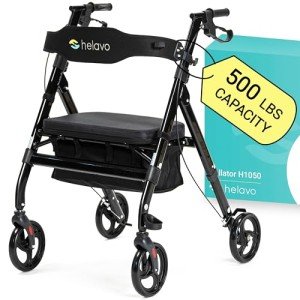What's The Current Job Market For Modern Walker Professionals?
페이지 정보
작성자 Bernd 작성일 25-09-25 14:29 조회 3 댓글 0본문
The Evolution of the Modern Walker: A Comprehensive Look
Walking has actually long been a basic human activity, essential for mobility and self-reliance. The modern walker, a crucial tool for those who need extra support while passing through the world, has actually progressed substantially for many years. This blog post will explore the advancement, types, benefits, and frequently asked questions about modern walkers, acting as a guide for anybody considering this mobility aid.
A Brief History of Walkers
The history of walkers can be traced back to the early 20th century. Initially created for rehabilitation, the first models were fundamental and supplied restricted support. However, as our understanding of mobility requires advanced, so too did the design and functionality of walking aids.
Timeline of Walker Development
| Year | Advancement |
|---|---|
| 1930s | The first walkers were created, primarily for rehab purposes. |
| 1960s | Introduction of Foldable 4-Wheel Walker designs for much easier storage and transport. |
| 1980s | Adoption of lightweight products, improving mobility without sacrificing strength. |
| 1990s | Introduction of walkers with wheels, assisting in smoother motion. |
| 2000s | Modern walkers integrated with additional features such as seats and storage compartments. |
The evolution of walkers shows not only developments in engineering and materials however likewise a growing awareness of varied user requirements.
Types of Modern Walkers
Today, there is a variety of walkers offered to accommodate various ages, mobility levels, and user choices. Below is a list of the most typical types:
Standard Walkers: Basic designs without wheels, offering maximum support. Ideal for those requiring substantial stability.
Wheeled Walkers (Rollators): Equipped with 2 or four wheels, these walkers enable for smoother motion. Lots of featured integrated seats for resting and storage for personal items.
Posterior Walkers: Designed to promote a more natural walking style, these are used by people recuperating from surgical treatment or injury.
Travel Walkers: Lightweight and collapsible, best for seniors and those on the go.
All-Terrain Walkers: Built with bigger wheels and sturdy frames, ideal for outdoor usage on uneven surface areas.
Contrast Table of Walker Types
| Type | Wheels | Seat | Stability | Mobility | Best For |
|---|---|---|---|---|---|
| Requirement Walker | No | No | High | Moderate | Users needing max support |
| Wheeled Walker | Yes | Yes | Moderate | High | Active users needing mobility |
| Posterior Walker | No | No | High | Moderate | Rehabilitation from injuries |
| Travel Walker | No/Yes | Optional | Moderate | Very High | Regular tourists |
| All-Terrain Medical-Grade Walker | Yes | Yes | Moderate | Moderate | Outdoor enthusiasts |
Benefits of Using a Modern Walker
Using a walker can considerably enhance the lifestyle for people with various mobility difficulties. Here's a breakdown of the main benefits:
- Increased Stability: Walkers decrease the danger of falls, using support and balance.
- Self-reliance: They empower users to move easily without dependence on others.
- Enhanced Posture: Walkers motivate users to keep an upright position, which can alleviate back pain.
- Versatility: With alternatives suited for different terrains and requirements, walkers can be tailored to specific preferences.
- Boosted Mobility: Many walkers are designed for ease of motion, permitting for more active way of lives.
Often Asked Questions (FAQ)
1. What size walker do I need?
Selecting the ideal size is vital for convenience and effectiveness. Preferably, walkers ought to be adjusted so that the handlebars are at wrist height when standing upright. Most designs are adjustable for height.
2. Can I utilize a Ergonomic Rollator Walker for long-distance Walking Aid?
While walkers offer exceptional support and stability, it is Best Rollator Walker to speak with a healthcare expert regarding long-distance usage, as fatigue can set in with time.
3. Do I require a prescription to acquire a walker?
In a lot of situations, a prescription is not required, but it's useful to consult with a physical therapist or doctor, especially for those with particular medical conditions.
4. How do I keep my walker?
Regular upkeep is crucial for security and functionality. Look for loose screws, tidy the tires or wheels, and inspect the frame for any wear or damage.
5. Are walkers covered by insurance coverage?
Lots of insurance plans cover walkers, particularly when prescribed by a medical professional. It's suggested to consult your insurance coverage service provider for particular standards.
The Modern Walker - enquiry - has actually come a long way from its early styles, evolving into a versatile aid that can accommodate a wide variety of mobility needs. With different types readily available, it is vital to think about individual requirements before purchasing. By comprehending the types, benefits, and maintenance of walkers, users can pick the right design to boost their mobility and self-reliance. As technology continues to advance, we can undoubtedly anticipate a lot more innovative styles in the future, further empowering people with mobility obstacles.

- 이전글 텍사스 홀덤 포커 족보, 룰 배울 수 있는 트럼프 카드 게임 올인 어비스
- 다음글 What Freud Can Teach Us About Order High-Quality Counterfeit Money
댓글목록 0
등록된 댓글이 없습니다.

